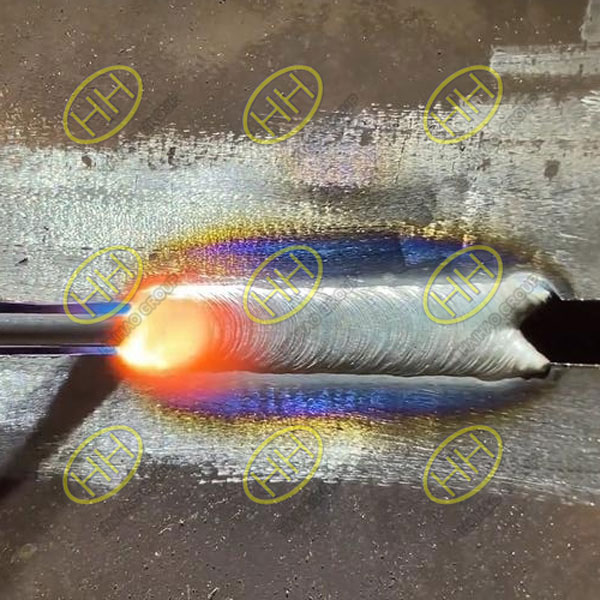In the field of industrial piping and pressure system manufacturing, welding quality directly affects product performance and reliability. As an expert in piping solutions, Haihao Group is committed to mastering every detail of the welding process—especially when it comes to stainless steel.
One of the most critical factors in stainless steel welding is interpass temperature control. Maintaining appropriate interpass temperatures helps preserve the mechanical integrity, corrosion resistance, and structural balance of the welded joint. Improper temperature management can lead to sensitization, cracking, or loss of corrosion resistance, especially in alloy-grade stainless steels.

The welding process of stainless steel
What Is Interpass Temperature?
Interpass temperature refers to the temperature of the base material in the weld zone before a subsequent welding pass is performed. It must be carefully regulated between weld passes, especially in multi-pass welding processes common in heavy wall piping or pressure components.
Interpass Temperature Guidelines by Stainless Steel Type
1.Austenitic Stainless Steel (e.g., 304, 316)
Recommended Range: ≤150°C (in strict applications, ≤120°C or even ≤100°C for thin plates)
Reason: Higher temperatures can cause chromium carbide precipitation, also known as sensitization, which severely compromises corrosion resistance, especially in environments rich in chlorides or acids.
2.Duplex Stainless Steel (e.g., UNS S31803 / 2205, UNS S32750 / 2507)
Recommended Range: 100–150°C
Reason: Duplex steels rely on a delicate balance between austenite and ferrite. Excessive heat can lead to the formation of intermetallic phases (like sigma or chi phase), resulting in embrittlement. Real-time monitoring is critical.
3.Martensitic Stainless Steel (e.g., 410, 420)
Recommended Range: 200–300°C (preheating often required)
Reason: To prevent cold cracking, especially in thick sections. However, over-heating must be avoided as it reduces hardness and mechanical strength after cooling.
4.Ferritic Stainless Steel (e.g., 430)
Recommended Range: ≤150°C (up to 200°C for thicker sections)
Reason: Excessive interpass heat can cause grain growth in the ferritic structure, reducing ductility and impact resistance.
Best Practices in Interpass Temperature Control
Measurement Method: Use calibrated contact thermometers or infrared devices. Measure around 25mm from the weld joint.
Active Cooling: In high-cycle or tight welding schedules, use compressed air or copper heat sinks for localized cooling—especially for austenitic grades.
Standards Reference:
AWS D1.6: Specifies ≤150°C interpass temperature for austenitic stainless steels.
ISO 15614-1: Interpass limits are defined based on welding procedure qualification data and material type.
Why Interpass Temperature Matters at Haihao Group?
At Haihao Group, our experienced welding team strictly controls interpass temperatures according to international codes and WPS/PQR data. This is particularly important for:
- Offshore pipeline systems
- Cryogenic applications
- High-pressure power plant components
- Corrosive process industry pipelines
Our QA/QC process includes temperature logs, weld traceability, and full documentation as part of our ISO-certified workflow.
Summary: Recommended Interpass Temperatures
| Steel Type | Typical Range (°C) | Key Concern |
| Austenitic (304/316) | ≤150°C (≤100°C thin) | Sensitization and loss of corrosion resistance |
| Duplex (2205/2507) | 100–150°C | Phase imbalance, intermetallic formation |
| Martensitic (410/420) | 200–300°C | Cold cracking, hardening control |
| Ferritic (430) | ≤150°C (≤200°C thick) | Grain growth and embrittlement |
Work With Welders Who Understand Your Materials
Haihao Group’s welding team undergoes continuous training in ASME, EN, and API welding procedures and is experienced in working with exotic alloys, duplex stainless, and cryogenic materials. We provide full welding documentation, including:
- WPS/PQR
- Interpass temperature logs
- Visual and NDT inspection reports
- Mechanical and metallurgical test records
Need Help With a Stainless Steel Welding Project?
Whether you’re building a pressure vessel, a chemical pipeline, or offshore modules, Haihao Group is ready to support your project with expert welding practices and reliable material solutions.
Contact us today to request technical support or a customized quote. Email:sales@haihaogroup.com







